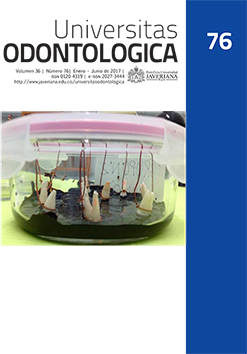Abstract
ABSTRACT. Background: In Venezuela, chimó is a blackish goo derived from tobacco leaf. Its consumption has been associated with systemic and oral diseases. Purpose: To identify in vitro dental erosion associated to chimó exposure. Methods: The sample consisted of 30 teeth that were assigned 10 to the negative control group, another 10 to the positive control group, and 10 to the experimental group, which were exposed respectively to artificial saliva, Coca-Cola® light, and chimó for 20 weeks. Tooth surfaces were analyzed clinically and structurally, the latter through scanning electron microscope. Results: Clinical observations showed surface color change in the negative control group; color change and surface gloss loss in the positive control group; color and surface changes in the experimental group (p=0.000). Ultrastructural analysis showed no enamel surface alterations in the negative control group. Acid etching scale values were 4 for the positive control group and 3-4 for the experimental group. The latter had signs of enamel erosion. In terms of severity of damage, the experimental group was type 1, that is, enamel loss without involving dentin. Conclusion: Under these experimental conditions, chimó caused clinical and ultrastructural enamel surface loss with type 3-4 erosion patterns, and type 1 severity.
Cuniberti N, Rossi G. Lesiones cervicales no cariosas. La lesión dental del futuro. 1ra edición. Buenos Aires, Argentina: Panamericana; 2009.
Willershausen B, Schulz-Dobrick B. In vitro study on dental erosion provoked by various beverages using electron probe microanalysis. Eur J Med Res. 2004; 9: 432-8.
Latorre C, Pallenzona M, Armas A, Guiza E. Desgaste dental y factores de riesgo asociado. Rev CES Odontol. 2010; 23(1): 29-36.
Bermúdez J. Lesiones en la mucosa bucal relacionadas con el consumo del tabaco de mascar (chimó). Reporte de un caso. Rev CES Odontol. 2011; 8: 141-50.
Rosales A, Sosa L, Dávila L, Quiñonez B, Jarpa P. Cambios clínicos periodontales ocasionados por el chimó en animales de experimentación. Rev Odontol Andes. 2008; 3(2): 21-7.
Jarpa P. Medición de pH de 12 preparaciones distintas de pasta de tabaco de mascar relacionándola con la adicción a la nicotina. Rev Fac Farm. 2003; 45(2): 7-11.
Parra J, Tovitto E, Jarpa P, Moreno G, Florido R, Omaña C. Determinación de cambios celulares en pacientes consumidores de chimó a través del estudio citológico. Rev Ven Inv Odontol IADR. 2014; 2(2): 116-25.
Dávila L, Jarpa P, Quiñónez B, Rosales A, Sosa L. Alteraciones histológicas ocasionadas por el tabaco de mascar venezolano (chimó) en los tejidos periodontales de ratas. Rev Cub Estomatol. 2009; 46(3): 38-47.
González J, García S, Araujo N, Echenique P. Prevalencia de consumo de tabaco no inhalado (chimó) en el municipio Miranda del estado Mérida, Venezuela: asociación con ansiedad y estrés. Rev Ven de Endocrinol Metab. 2011; 9(3): 99-105.
Kallischnigg G, Weitkunat R, Lee P. Systematic review of the relation between smokeless tobacco and non-neoplastic oral diseases in Europe and the United States. BMC Oral Health. 2008; 8:13.
Jarpa, P. Potencial mutagénico del tabaco de mascar venezolano. Rev Fac Farm. 2003; 45(2): 2-6.
Meléndez J, Varela R, Cueto G, Mondragón J, Carrillo L, Coronado E, García E, Rojo C, Orozco K. Evaluación del grabado del esmalte en piezas con ápice inmaduro y maduro utilizando ácido ortofosfórico al 37% por medio de microscopia electrónica de barrido. Acta Odontol Ven. 2002; 40(1): 26-30.
Eccles JD, Jenkins WG. Dental erosion and diet. J Dent. 1974; 2(4):153-9.
Herrera M, Uzcátegui M. Efectos del consumo del chimó en resinas compuestas. Un estudio in vitro. [Tesis de grado]. Mérida, Venezuela: Universidad de Los Andes. Facultad de Odontología; 2009.
Borjian A, Ferrari CC, Anouf A, Touyz LZ. Pop-cola acids and tooth erosion: An in vitro, in vivo, electron-microscopic, and clinical report. Int J Dent. 2010; 2010: 957842.
Navarro R. Estudio mediante microscopio electrónico de barrido de los efectos producidos por Coca-Cola® y Schweppes® limón en el esmalte intacto y en el esmalte grabado y sellado con una resina ortodóncica. [Tesis de grado]. Murcia, España: Universidad de Murcia. Facultad de Medicina; 2006. [citado 10 Feb 2016]. Disponible en: https://digitum.um.es/xmlui/bitstream/10201/26885/1/TESINA_Ra%C3%BAl.Navarro.Garre.pdf.
Moreno X, Narváez C, Bittner V. Efecto in vitro de las bebidas refrescantes sobre la mineralización de la superficie del esmalte dentario de piezas permanentes extraídas. Int J Odontostomatol. 2011; 5(2): 157-63.
Flores C, Martínez J, Palma M, Yáñez J. Análisis del grabado dental utilizando el microscopio metalográfico y el software analySIS. Inform Tecnol. 2009;20(2): 13-8.
Barral D, Rodrigues L, Campos E, Correia R. In vitro study on tooth enamel lesions related to whitening dentifrice. Indian J Dent Res. 2011; 22(6): 770-6.
Ghiorghe C-A, Topoliceanu C, Pancu G, Stoleriu S, Iovan G. SEM study regarding dental erosion on extracted teeth immersed in hydrochloric acid. Rom J Oral Rehab. 2013; 5(3): 100-4
This journal is registered under a Creative Commons Attribution 4.0 International Public License. Thus, this work may be reproduced, distributed, and publicly shared in digital format, as long as the names of the authors and Pontificia Universidad Javeriana are acknowledged. Others are allowed to quote, adapt, transform, auto-archive, republish, and create based on this material, for any purpose (even commercial ones), provided the authorship is duly acknowledged, a link to the original work is provided, and it is specified if changes have been made. Pontificia Universidad Javeriana does not hold the rights of published works and the authors are solely responsible for the contents of their works; they keep the moral, intellectual, privacy, and publicity rights.
Approving the intervention of the work (review, copy-editing, translation, layout) and the following outreach, are granted through an use license and not through an assignment of rights. This means the journal and Pontificia Universidad Javeriana cannot be held responsible for any ethical malpractice by the authors. As a consequence of the protection granted by the use license, the journal is not required to publish recantations or modify information already published, unless the errata stems from the editorial management process. Publishing contents in this journal does not generate royalties for contributors.


